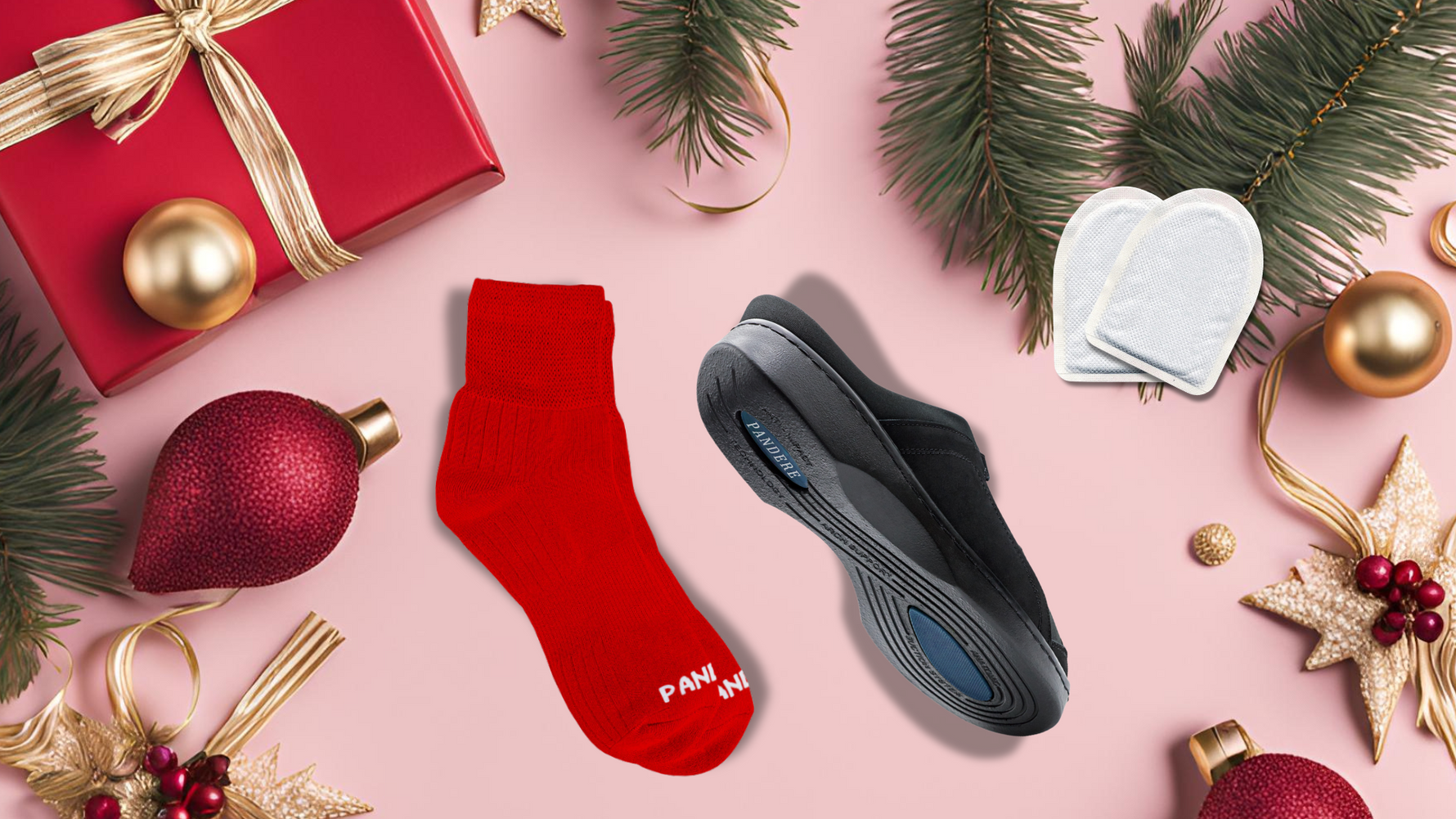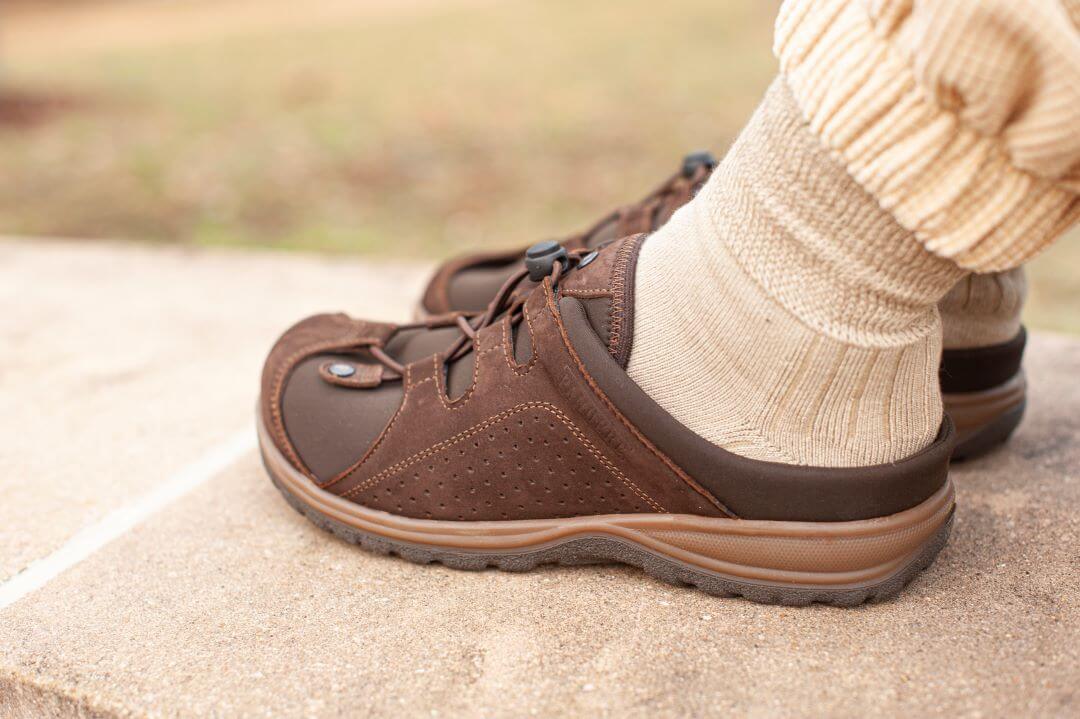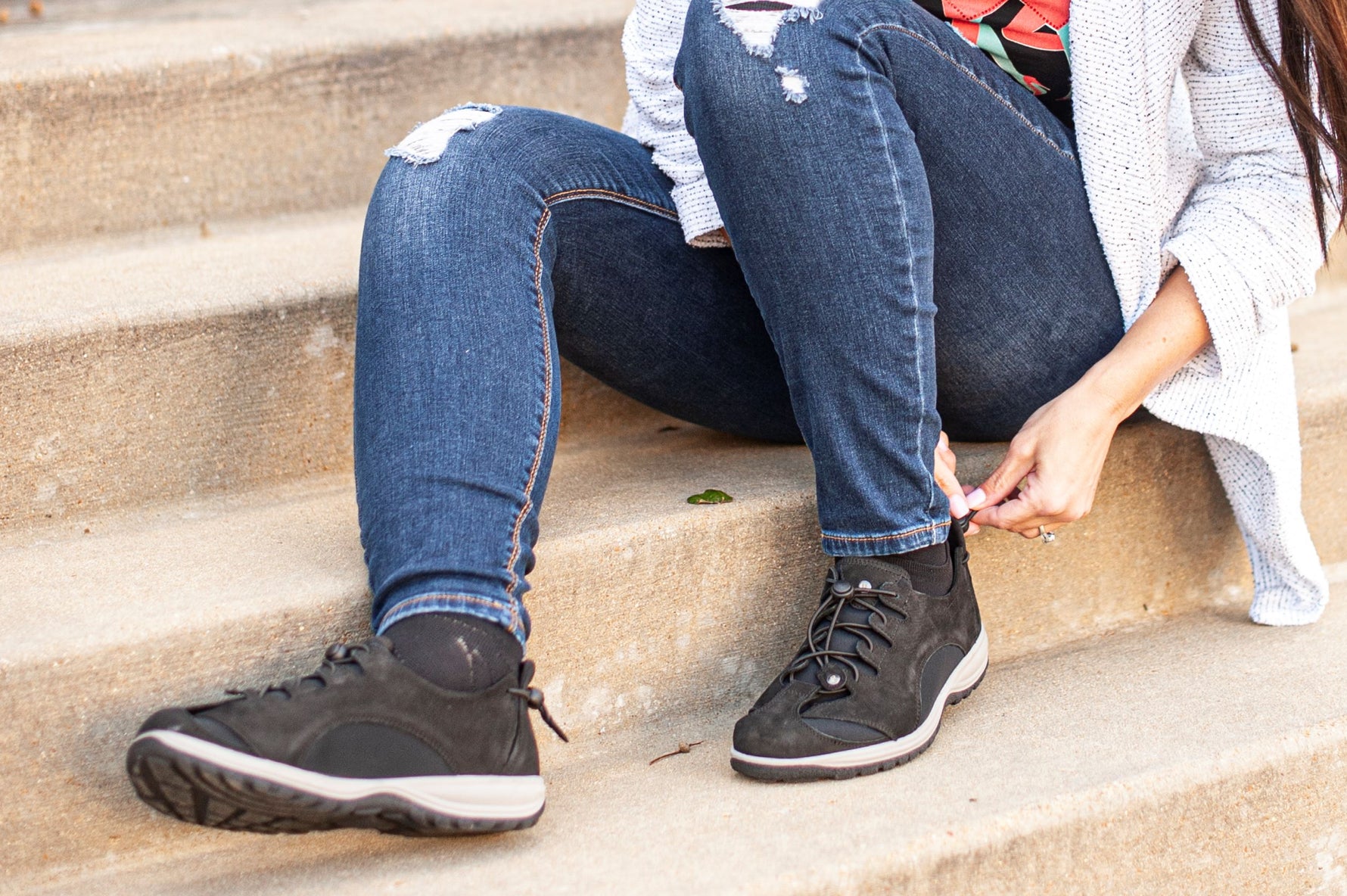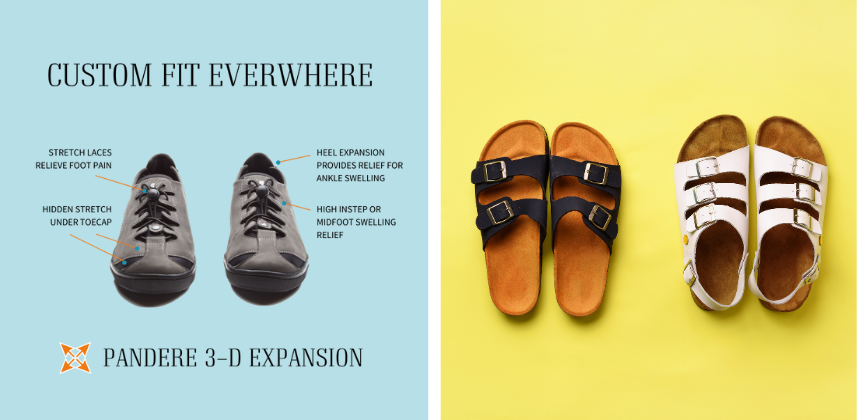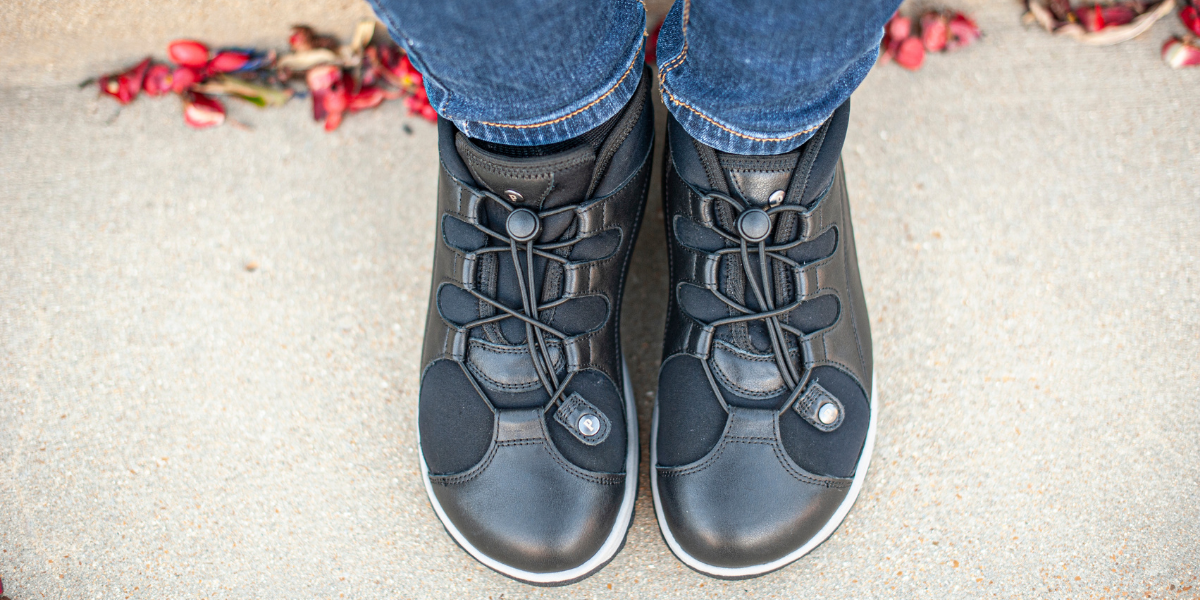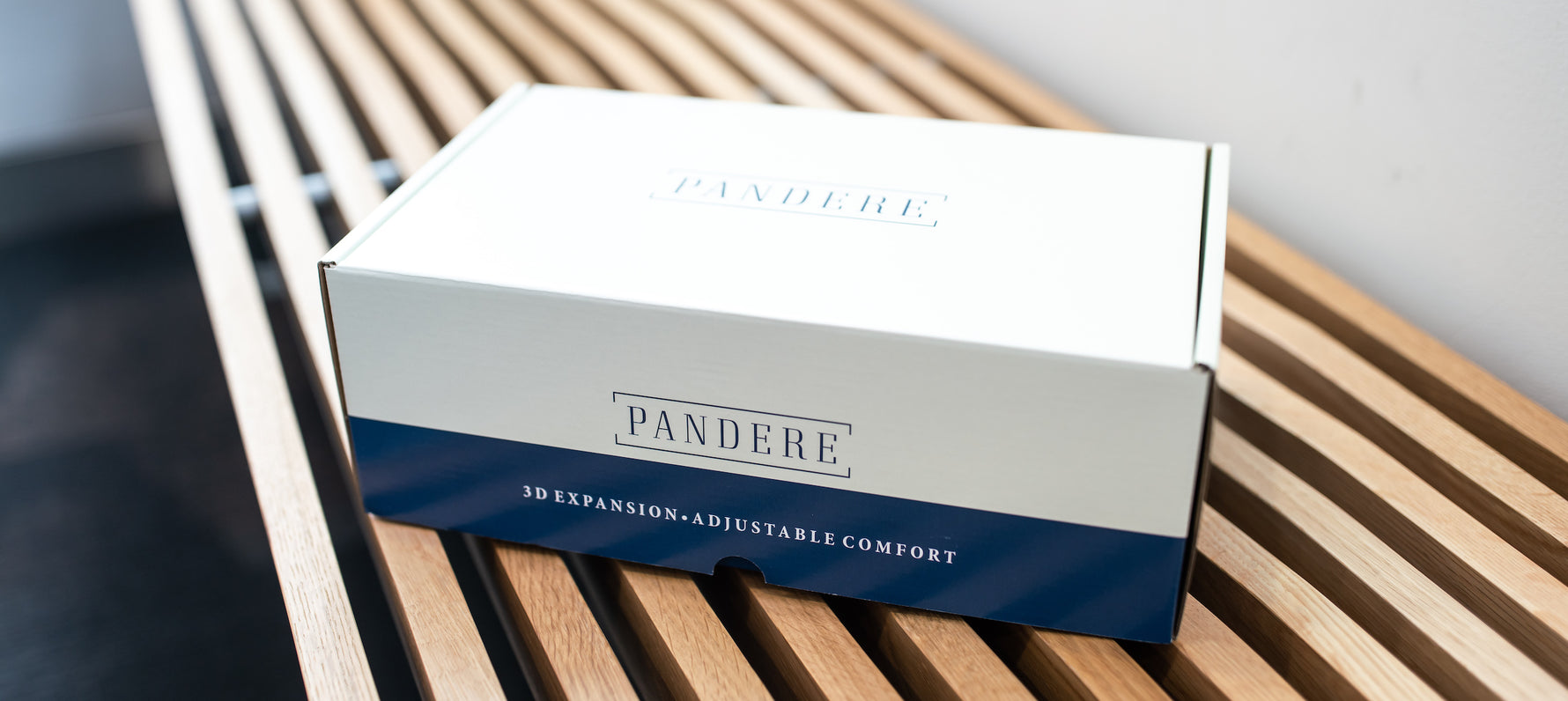You want your shoes to be comfortable. You want them to fit your feet well. And if you have trouble with swelling in your feet, you absolutely want to find the best shoes for edema. Too often, however, we struggle with finding the right shoes for edema feet. It can be challenge to find shoes that are comfortable, fit well and meet the right tone for various occasions.
This is why we settle on shoes that might not be totally comfortable all of the time. Or we risk embarrassment by wearing comfortable shoes that are not appropriate for various events or activities. Nobody wants to wear shoes that don’t fit. And nobody wants to waste money and time on returning shoes. That’s why it is important to try to find the right edema shoes when you are looking for the best shoes in your situation.
It’s easy to understand how you might wind up with the wrong shoes, of course. We all make mistakes. Here are the most common mistakes everyone makes when buying edema shoes.
1. You bought the wrong size
Many of us don’t actually know our own shoe size. You might have an idea in your mind about what size shoe you wear, but that doesn’t mean it is actually the correct size. Buying shoes in the wrong size isn’t just a problem with shoes for edema patients. It’s a universal problem.
What is most important to note is that you will never wear a single shoe size. Shoe manufacturers have different size guidelines and different styles of shoes fit your feet differently. You might wear a 7 in dress shoes, but need a 6.5 in sandals to keep them on your feet and even an 8 in athletic shoes. This can make shoe shopping a challenge, even before you add in the swelling that creates problems finding shoes for edematous feet.
Your best bet is to first get measured for shoe sizes on a regular basis. Feet grow and spread over time. Your feet can change shape. Get measured every six months to a year to be sure you’re wearing the right size shoe. Then, try on your shoes as best you can before you buy them. If you know that in one brand you wear a larger size than in another brand, you can use that information as you shop online for shoes. Or, even better, skip the sizing issues all together and simply buy adjustable shoes for edema.
2. You didn’t read reviews
Shopping online has tremendous benefits over shopping in stores, specially for shoes for people with edema. You have greater options in footwear. You have expanded sizes. You also have specifically made shoes for edematous feet.
But what makes online shopping even better is that you have access to reviews as well. If you are looking at edema footwear, but want to know more about how the shoe fits, what other customers are experiencing with the shoe or simply what the material feels like, you can read the reviews. There are multiple websites dedicated to reviews on footwear and to the companies that make it.
If you don’t read the reviews, you may not know what to expect in terms of delivery and returns, or if the shoes tend to run big or small. Read what others have said, and write up your own experience in turn to help those shopping later.
3. You didn’t fit the widest part of your foot
Edema footwear needs to fit the widest part of your foot. If you suffer from edema and also have high arches or a bunion, you should take that into account when you’re shopping. Just like you should buy clothes for the widest part of your body, you should be buying shoes for the widest part of your foot.
If you realize that your shoes are too loose in other ways once you fit the widest part, it may be that you need to shop for another brand of shoe, another style or perhaps just find a pair of adjustable shoes for edema.
4. You chose fashion over comfort
We all want to look and feel good in our shoes. But looking good shouldn’t matter more than feeling good. If you choose fashion over function, you might get away with it for a little while. But eventually you’re going to have problems.
Fashionable shoes often are made without much consideration for comfort, and they are certainly not designed to accommodate wider feet or those with feet that swell during the day. Even if you absolutely love a pair of shoes because they are so stylish, forcing your feet into those shoes can lead to long-term foot damage and short term pain. Buy shoes that fit comfortably instead.
5. You didn’t leave room for growth
Buying shoes for children requires leaving a bit of room in the toe for feet to grow. Buying the best shoes for edema means almost the same thing. You need to buy shoes that have some wiggle room or give to accommodate your feet and ankles throughout the day.
Adjustable shoes for edema offer plenty of ways to make room as your feet swell, especially if your feet swell a great deal during the day and then come down in size overnight. But even without adjustable shoes for edema, choose your shoes carefully to be sure they have room at the sides and the top of the shoe to accommodate swelling.
6. You bought a shoe designed for men
If you’re a man looking at men’s shoes for edema, this is a mistake that doesn’t apply to you. However, if you’re looking for shoes for women with edema, you might be tempted to check out the selection for men. This might be a mistake, however, because women’s footwear is not the same as men’s. While some shoes are interchangeable between men and women – slides, for example – others are not as versatile.
If you are looking for professional shoes tailored to a woman’s smaller foot, you can’t just buy men’s shoes and expect them to fit the bill. The best shoes for women with edema are shoes that incorporate feminine styles but include options for growth and stretch during the day. Men’s shoes are often bulkier, heavier and might not be much wider than traditional women’s shoes.
7. You bought shoes too quickly
If you grab the first pair of shoes that comes in your size, you may be buying your shoes too quickly. Shoes fit differently and they can vary in fit even in the same manufacturer. Don’t just grab the first pair you try on that seem tolerable. Instead, try on a few different pairs or buy multiple pairs online with plans to return the ones that don’t fit well. Just be sure you research the return policies first!
Trying on multiple shoes before committing to a purchase allows you to test different brands and different styles. Grab and go footwear purchases might leave you a pair that fits, but you might have missed an opportunity to get something much better. At the very least, you’ll have a better idea of sizes and fit across multiple brands and shoe styles by trying on a large selection.
8. You think all shoes are naturally a bit uncomfortable
If you’ve been wearing regular shoes instead of edema shoes, you have likely experienced some of the discomfort that comes from poorly fitted footwear. But if you’ve been jamming your feet into poorly fitted shoes for a long period of time, you may not even recognize how accustomed you’ve become to discomfort.
It is not normal for your shoes to be uncomfortable. Your feet should not hurt every time you have to wear your shoes. If you can’t find comfortable edema shoes, then consider new brands or special adjustable shoes for edema that you can customize to your liking.
9. You didn’t buy shoes with enough support
One thing that has been known to happen when looking for edema shoes, is trading too much comfort for a lack of support. Not having a solid shoe supporting your arches and heels can result in foot and even hip pain over time. You need plenty of give and room in your edema footwear, but wearing slippers all of time can be dangerous to your ongoing foot health.
Find shoes that are soft like slippers around your feet, but blend that softness and comfort with a study sole that includes proper arch support and some give for when you walk to protect your feet, especially if you are on your feet for long stretches of time on a daily basis.
10. You didn’t try your shoes on with socks
If you are used to wearing slippers or slides on a regular basis, you might have gotten in the habit of wearing your shoes without socks. But when you go to try on your shoes for edema feet, you need to be sure that you are trying on shoes the way you’re going to wear them on a regular basis. That means if you are trying on shoes for work, then you need to be trying on your shoes with socks.
Shoes fit differently over bare feet than they do over socks. Different socks also can make a difference as well in how shoes fit as well. Thicker socks can help protect your feet, especially as feet adjust in size throughout the day. Thinner socks can help shoes fit more smoothly over your feet. Be sure that you try on shoes with the socks you plan on wearing with them on the daily basis.
11. You shopped for shoes in the morning
All feet grow in size over the course of the day. This is especially true for those suffering from edema. Edema shoes should take this natural growth into account, but we don’t always remember how much our feet can swell if we shop for shoes in the morning. The best time to shop for new shoes for people with edema is when your feet are most swollen, likely at the end of the day.
This ensures that you have shoes that fit comfortably when your feet and ankles are at their least comfortable. Even if you are shopping online for new shoes for edema patients, be sure to measure your feet at the end of the day and use those measurements as you are finding the proper size. Remember that adjustable shoes for edema will have the most grace in sizes, often allowing you to change the size of the overall shoe as the day progresses so that the time of day doesn’t matter as much for shoe shopping purposes.
12. You only tried on one shoe
We’ve all done it. You’re in a hurry or trying on lots of pairs of shoes, so you simply try on one shoe in the pair to get an idea of how they fit. This can be a mistake. Everyone’s feet are different sizes. And when your feet swell due to edema, they are going to be even less evenly matched.
To decide if a shoe fits comfortably, you should be trying on both shoes in a set. It is very possible that a shoe may fit your right foot differently than it fits the left. To find the best shoes for edema, you need to try on the full set – don’t buy a pair of shoes when you’ve only tried on half of the purchase.
13. You assume a shoe will stretch over time
In the case of leather shoes and boots, you can expect a bit of stretch over time. Some people still buy shoes a bit snug anticipating some stretch over time. After all, if a shoe stretches too much, it will wind up too big. This is not the right advice for edema footwear, however.
You can count on your feet growing over the course of the day and possibly the week. Modern shoes are often not constructed of leather, which means they aren’t going to do any stretching. If they do, it will be minimal and it will come at the expense of your feet. Buy shoes that fit the first time you try them on. Don’t assume the shoes will stretch to accommodate your feet, because they probably won’t.
14. You bought one pair of shoes for all occasions
Edema shoes can be a challenge to find, and when you find a pair that is comfortable and fits well, it’s natural to want to wear that shoe as often as possible. After all, isn’t a comfortable set of edema shoes the goal?
It is absolutely true that you want your edema shoes to be comfortable. But you don’t want a single pair of shoes for all occasion. Don’t fall into the trap of buying a single pair of shoes and then trying to make that pair work for every single thing you do over the course of the day or week.
You can’t jog in your work shoes. You can’t work in an office in the same shoes you use to cut the grass. Find a brand of edema shoes that works for you and fits well. Then invest in multiple pairs to help you cover the range of activities you can expect in your daily life.
